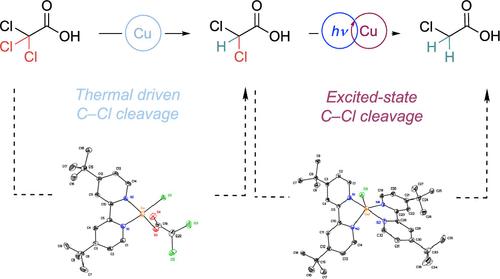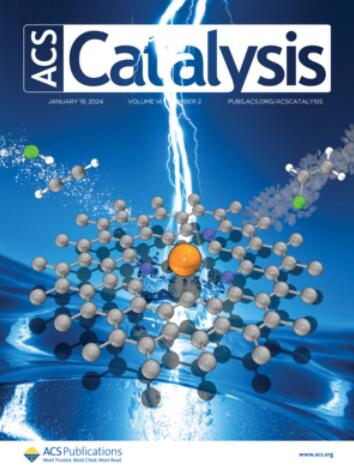Visible-Light-Driven Catalytic Dehalogenation of Trichloroacetic Acid and α-Halocarbonyl Compounds: Multiple Roles of Copper
IF 11.3
1区 化学
Q1 CHEMISTRY, PHYSICAL
引用次数: 0
Abstract
Herein, we report the reaction development and mechanistic studies of visible-light-driven Cu-catalyzed dechlorination of trichloroacetic acid for the highly selective formation of monochloroacetic acid. Visible-light-driven transition metal catalysis via an inner-sphere pathway features the dual roles of transition metal species in photoexcitation and substrate activation steps, and a detailed mechanistic understanding of their roles is crucial for the further development of light-driven catalysis. This catalytic method, which features environmentally desired ascorbic acid as the hydrogen atom source and water/ethanol as the solvent, can be further applied to the dehalogenation of a variety of halocarboxylic acids and amides. Spectroscopic, X-ray crystallographic, and kinetic studies have revealed the detailed mechanism of the roles of copper in photoexcitation, thermal activation of the first C–Cl bond, and excited-state activation of the second C–Cl bond via excited-state chlorine atom transfer.

求助全文
约1分钟内获得全文
求助全文
来源期刊

ACS Catalysis
CHEMISTRY, PHYSICAL-
CiteScore
20.80
自引率
6.20%
发文量
1253
审稿时长
1.5 months
期刊介绍:
ACS Catalysis is an esteemed journal that publishes original research in the fields of heterogeneous catalysis, molecular catalysis, and biocatalysis. It offers broad coverage across diverse areas such as life sciences, organometallics and synthesis, photochemistry and electrochemistry, drug discovery and synthesis, materials science, environmental protection, polymer discovery and synthesis, and energy and fuels.
The scope of the journal is to showcase innovative work in various aspects of catalysis. This includes new reactions and novel synthetic approaches utilizing known catalysts, the discovery or modification of new catalysts, elucidation of catalytic mechanisms through cutting-edge investigations, practical enhancements of existing processes, as well as conceptual advances in the field. Contributions to ACS Catalysis can encompass both experimental and theoretical research focused on catalytic molecules, macromolecules, and materials that exhibit catalytic turnover.
 求助内容:
求助内容: 应助结果提醒方式:
应助结果提醒方式:


